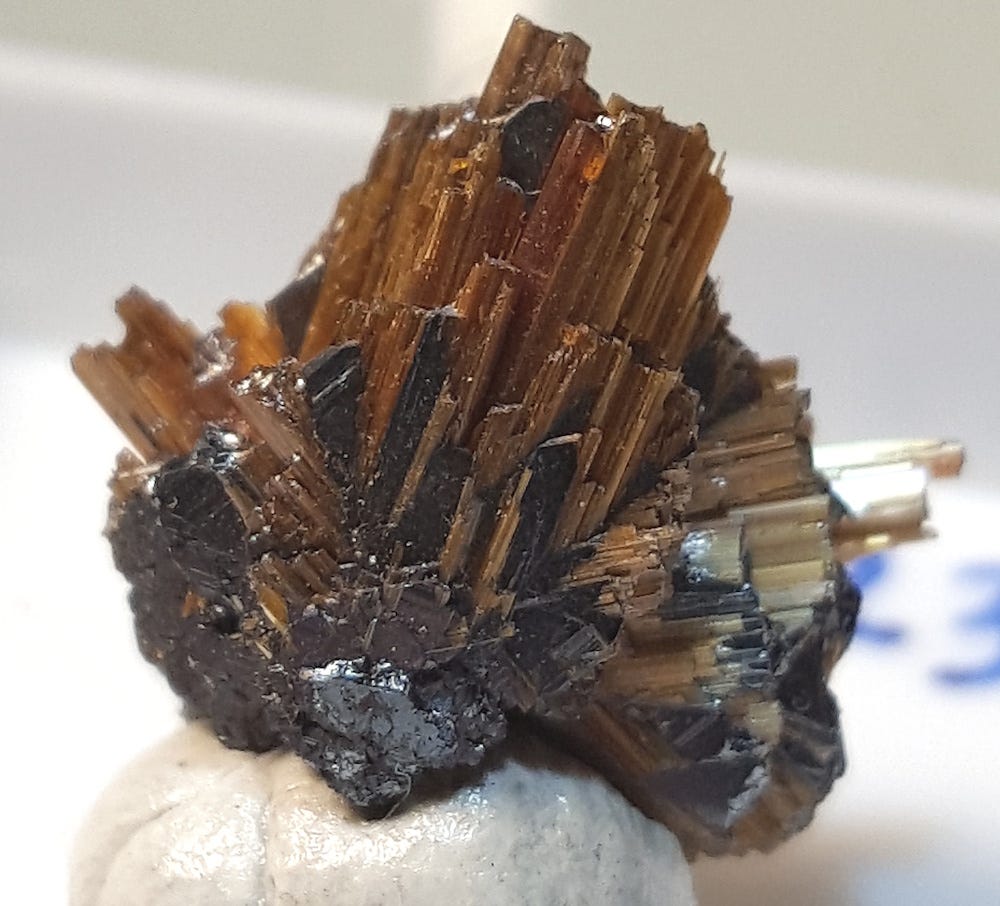Rutilated quartz
The rutile came first
Life in the USA is not normal. It feels pointless and trivial to be talking about small looks at the fascinating natural world when the country is being dismantled. But these posts will continue, as a statement of resistance. I hope you continue to enjoy and learn from them. Stand Up For Science!
“Rutilated quartz” makes it sound like you had some quartz that got shot through with needles of rutile, and the metaphysical sites typically use phrases like “quartz penetrated by rutile” that perpetuate this misconception.
Rutile melts or crystallizes at around 1855° C (3360° F), whereas quartz crystallizes in rocks at about 650° C or lower. So if the rutile (titanium dioxide) was liquid, the quartz would have been liquid, too. It would be more accurate to think of this as a case in which needle-like rutile crystals had already grown and solidified in a cavity, where later, as the temperature dropped, the quartz crystallized around the pre-existing rutile.
Edit: As pointed out in a comment by Russell Seitz below, “the rutile came first by hydrothermal growth, not by freezing out of a silicate melt. The melting point of TiO2 has nothing to do with its solubility in supercritical fluids, and temperatures over 3,000º K are not encountered in the earth's crust.”
Titanium (as ions of the element, not the mineral rutile) has been used to estimate crystallization temperatures in quartz (Tailby and others, 2017, Rutilated quartz: combining Ti-in-quartz thermometry and lattice diffusion: American Geophysical Union, Fall Meeting 2017, abstract #V51G-06).

Novo Horizonte, Brazil, is a famous locality for rutilated quartz like this, where the minerals grew in pegmatites (late-stage igneous bodies, typically containing large crystals of unusual minerals, enriched in things like lithium, beryllium, rare earths, boron, and titanium). Those pegmatites were probably related to granitic intrusions that were generated by the amalgamation of the São Francisco Craton in eastern Brazil with the Congo Craton in central Africa.
That was part of the Pan-African/Brasiliano orogeny that contributed to the formation of the supercontinent of Gondwana about 570 to 650 million years ago during Neoproterozoic time. The collision may have rejuvenated faults that were much older, established in the Paramirim Aulacogen (“aulacogen” is from Greek meaning “a furrow” and in geology it is a failed rift system) that probably formed and developed over a rather long time span, from as long ago as 1775 million years to as recently as 900 million years. That much time has to represent multiple deformation episodes.
My specimen at top is about 4 cm long. The straw-colored rutile needles are not oriented randomly but grew in sheafs focused on particular faces of older black hematite (iron oxide) crystals, more evident in the right-hand photo. That arrangement is called epitaxy, when one mineral grows in a preferential position on another due to similarities in their crystallographic structure at a molecular level. Epitaxy comes from Greek words meaning “above” and “in an ordered manner,” for the superimposition of one mineral on or above another dependent on the similarities of their crystallographic order. Rutile is from Latin rutilus, red, for its typical color. The straw or golden color here is also typical of rutile and may reflect some iron in the rutile structure.



The rutile came first by hydrothermal growth- not by freezing out of a silicate melt. T
The melting point of TiO2 has nothing to do with its solubility in supercritical fluids, and temperatures over 3,000º K are not encountered in the earth's crust.
There is an old pegmatite mine on the original highway near Pipestone pass; itthe pegmatite mine has a name but I cannot recall it. I found several samples there of tourmalinated quartz, as well as specimens of hair-like tourmaline not encased in anything. You may know of this old mine.